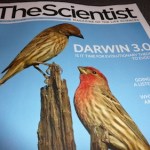Biology (Macroscopic )
Sucrose
Molecules of sucrose tore apart in their bellies letting glucose course free in their veins.
Luckily for us, a system evolved long ago to capture that glucose and minimize it's potential for damage. Removing sugar from the blood and sequestering it in liver, fat, and muscle cells, minimizes the harm that might result if sugars were free to bind to proteins and our bodies were stressed by trying to flush excess glucose out of our system.
This holiday season, we give thanks for insulin and the biotech companies like Genentech that cloned the human gene and began to…
This month's cover of The Scientist has a mistake that makes me cringe.
Can you spot what's wrong?
And they call themselves "The Scientist" humph!
We always enjoy home science experiments and it was fun the other night to learn about a new experiment we could try with our teenage daughter and an iPhone.
As it turned out, the joke was on us.
My husband is an enthusiastic fan of the iPhone store. Last night, he downloaded this application called "Army Knife."
This application has, I kid you not, the following nine items:
unit converter - these are always helpful, especially if you travel
ultrasonic whistle
protractor
Heart (beats per minute) counter
measuring tape
digital caliper
Two levels
flashlight
emergency SOS light
Some of…
"Digital biology," as I use the phrase, refers to the idea of using digital information for doing biology. This digital information comes from multiple sources such as DNA sequences, protein sequences, DNA hybridization, molecular structures, analytical chemistry, biomarkers, images, GIS, and more. We obtain this information either from experiments or from a wide variety of databases and we work with this information using several kinds of bioinformatics tools.
The reason I'm calling this field "digital biology" and not "bioinformatics" (even though I typically use the terms as…
I suppose I should have expected this.
I thought it might be fun to see what the databases had to say about turkeys.
Technorati Tags: Thanksgiving,, turkey,, mash-up
So, I queried the NCBI databases, found a taxonomy reference, and started clicking related links to see pictures of the different species.
Why?
Because it would be great to see what the different species of turkies look like and compare them.
Here's a species of wild turkey that I didn't expect to find.
Wild turkey, humph!
A loose spider on a space station.
Technorati Tags: humor, 'snakes, on, a, plane', spider, spiders, 'space, station'
Apparently the missing orb-weaver spider is gone from it's cage and can't be found anywhere.
And for the record, I don't know what kind of spider is in my photograph. It's a spider that lives in Fairbanks, AK.
From the Telegraph:
It was hoped the missing spider might have sought refuge in its neighbour's tank, but the remaining spider has spun a web so thick, to cope with the zero-gravity conditions, that is is impossible to check.
The runaway spider, which was meant to be the…
Yes, that's right, another Medicine 2.0 blog carnival has been posted for your enjoyment.
And the host, Ivor Kovic, has done an amazingly creative and interesting thing with images from all the past hosting places..., and well, you just need to go see it yourself.
I used to get e-mails from relatives that were filled with cute pictures of kittens and puppies. It's luck they didn't know about this site:
http://www.zooborns.com/
These are the some of the absolutely cutest baby pictures I have ever seen!
I hear Raffi songs in my head when I look at these (can you sing Baby Beluga?)
The Galápagos islands rank high on my list of places that I really, really, really want to visit. But for many reasons, it's always looked like a trip to the Galápagos would be at least a decade or two away.
Now, I'll be able to go in January and so will all of you.
Thanks to the University of Cincinnati, we'll be able to follow in Darwin's historic steps, and experience some of his amazing journey.
The only difference is we'll do this trip as avatars in Second Life.
The University is stocking this intriguing exhibit with photos and images from the Galápagos, as part of a 150 year…
Then you need to head over to The Oyster's Garter and read Miriam Goldstein's incredibly funny post about the problems of male sea squirts.
Apparently, if you're a sea squirt, the size of your sperm is related to your environment and mostly the number of other sea squirts in your environment.
Usually, I'm not attuned to the issues of broadcasting spawn or the lives of those who live under a dock, but Ms. Goldstein channels Dr. Tatiana so well, I found myself sympathizing and laughing out loud at the struggles of the tunicates.
Sometimes extremely handsome pleats just aren't enough.
Part I. The back story from the genome record
Together, these five posts describe the discovery of a novel paramyxovirus in the Aedes aegyptii genome and a new method for finding interesting anomalies in GenBank.
I. The back story from the genome record
II. What do the mumps proteins do? And how do we find out?
III. Serendipity strikes when we Blink.
IV. Assembling the details of the case for a mosquito paramyxovirus
V. A general method for finding interesting things in GenBank
I began this series on mumps intending to write about immunology and how vaccines work to stimulate the immune…
Vaccines work by stimulating the immune system to respond to a specific thing. Most of the vaccines we use are designed to prime the immune system so that it's ready to fight off some kind of disease, like whooping cough, polio, or influenza. Some vaccines can have more specialized functions, like stimulating the body to attack cancer cells, kill rogue autoimmune cells, or prevent pregnancy. We'll look at what they do in later posts, for now, let's look at the kinds of things that can be used as vaccines.
It's an amazing assortment. Even more amazing is that these items don't all work in…
Every year people adopt pet dogs, cats, birds, and other creatures and take them to their local veterinarians for all the usual vaccinations and exams. The usual vaccinations protect your pets from diseases like rabies, distemper, Feline Immunodeficiency Virus, and Feline Leukemia. But it's not just pets that get protected by vaccines. Agricultural creatures: fish, chickens, sheep, cows, pigs, and horses receive vaccines and increasingly, wild animals are getting vaccinated, too.
One example comes from the National Center for Ecological Analysis and Synthesis. They are looking at ways to…
write your Senators and Representatives about saving the Endangered Species Act.
But, first read what Mike Dunford has to say. Mike describes the changes that the Bush administration has proposed in great detail and consequences for wild animals. Greg Laden has posted on this, too.
It was a -1 tide on Sunday and great entertainment for people and birds.
We got there about lunch time.
We found two moonsnails.
Lots of moonsnail egg cases.
Some moonsnail food.
Anenomes everywhere.
And at the end, we had quit being crabby.
And everything was clam.
What are you learning in school?
xkcd has the inside track on the really important stuff.
Yesterday morning I was sitting at conference table, downing coffee to keep my eyes open, when I heard someone say that it's springtime now and the snakes are waking up. Well, those kinds of statements at the breakfast table do have a way of getting my attention.
I turned sideways and realized the words were coming from a high school science teacher, that I know, from Arizona.
"Snakes hibernate?"
"Sure," she said, "and people who move here in the winter time are pretty surprised when a snake wakes up and crawls out from under their porch."
A few other questions and everyone at the table…
This morning I had a banana genome, an orange genome, two chicken genomes (haploid, of course), and some fried pig genome, on the side. Later today, I will consume genomes from different kinds of green plants and perhaps even a cow or fish genome. I probably drank a bit of coffee DNA too, but didn't consume a complete coffee genome since my grinder isn't that powerful and much of the DNA would be trapped inside the ground up beans.
Of course, microbes have genomes, too. But I do my best to cook those first.
So, what is a genome? Is it a chromosome? Is it one of those DNA fragments or…
Conflicts between predators like cougars and coyotes and human companions like pets and small children are becoming more common as people move into areas that used to be wildlife habitat.
The Seattle Times has a great story this morning about biologists in Washington who are studying cougars to learn if cougars and people can coexist. The biologists think most of the trouble might be caused by teenage male cougars who move in to the territory when the older, smarter males get killed.
There's also a cool video
Your canopy is disappearing, you're likely to freeze.
NASA's Earth Observatory reports that over 1,110 acres of forest were illegally logged, during the past four years, in the Monarch Butterfly Biosphere Reserve in central Mexico.
Monarch butterflies travel here from all over the United States and Canada. Images from the Ikonos satellite tell us though, that future migrating butterflies are likely have problems in this reserve. The top image is from 2004, the bottom image shows what things are like now.
NASA's Earth Observatory
Without the trees to protect them, the butterflies could…


